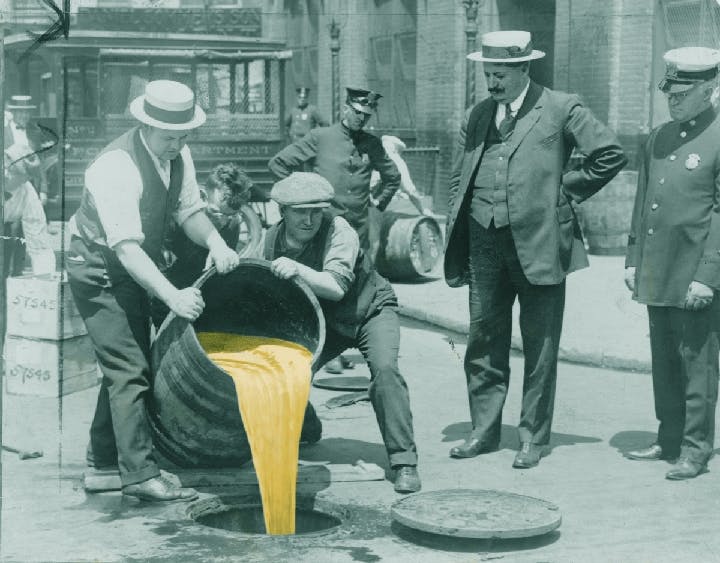What Prohibition can teach us about immigration reform
– Molly Banta
Are laws only effective when they have the moral consensus of society? Prohibition's failure seems to suggest so.
The concept of banning the production and sale of alcohol began as a primarily religious grassroots movement in the 1870s. Prohibition, as it came to be called, experienced varying levels of popularity throughout the United States while becoming a cause célèbre for a mishmash of activists ranging from religious fundamentalists to suffragists (many of whom blamed alcohol for epidemic-level domestic abuse of women) to nativists (who associated drunkenness with undesirable immigrant populations). Ratified on January 16, 1919, the 18th Amendment became just the second constitutional change to explicitly prohibit the conduct of the American people rather than that of the government (the 13th Amendment was the other). By then, some twenty-six states already enacted versions of the ban, mostly in heavily religious and the country’s more rural areas. For the pious, alcohol was a corruption — an evil that led only to greater evils — and prohibition a moral necessity for the sake of the social order and public welfare.
As hard times came, the Great Depression sowed doubt in any correlation between a dry country and a strong country. Public support for Prohibition plummeted. Compliance with Prohibition was no longer a moral obligation, but merely a legal one — popularizing a notion that certain conduct (e.g. consuming alcohol) was wrong simply because the law prohibited it, not because of any practical or moral consensus. Abiding by the law only so long as it is practical or follows your own moral values has its obvious problems, but, consciously or not, this is often what dictates how and when we follow the law. Many people illegally jaywalk across streets, but would never think to drive through a red light; practicality aside, they may believe that the latter law is integral to the social order of their community, while jaywalking does not yield greater mayhem.
In the Georgetown Immigration Law Journal, Andrew Moore argues that this Prohibition-era distinction between moral and legal acquiescence can be useful to facilitate a more productive public discourse on immigration, allowing the dialogue to move past flat arguments over whether or not a behavior broke the law and on to more meaningful nuances, such as why so many immigrants violated the law to live and work in the United States.
The historical narratives of Prohibition and the anti-immigration movements in America are intimately intertwined. Following relatively lax immigration laws in the United States at the beginning of the twentieth century, the Prohibition movement considered immigrants — many of whom came from cultures with more permissive attitudes towards alcohol, and who, in the United States, formed the backbone brewing industry — as the primary obstacle to a dry and morally-sound nation. Nativism and Prohibition worked side by side: the one-two punch of Prohibition and new, restrictive immigration laws led to the creation of the U.S. Border Patrol in 1924. Each movement has roots in moral obligation, with teetotalers (whether concerned about immigrants or alcohol) fretting that the nation’s identity and sovereignty is being diluted. Prohibition attempted to ‘correct’ the behavior of a country of heavy drinkers; the anti-immigration movement still attempts stop the flow of immigrants who come from sundry cultures and often do not speak English. The moral motivations of each movement are over-simplified, yet obvious: we need sovereignty to protect our identity.
During Prohibition, as soon as the American people no longer saw the law as a moral obligation, enforcement fell apart. Parallels between the enforcement of immigration law and Prohibition abound: a border difficult to police, abusive policies by both law enforcement and smugglers, and dangerous implications from an unregulated market. Moore argues that America is unable to get past immigration enforcement as legal obligation, and either unable or unwilling to confront the complex moral and practical issues behind it. The tendency to conflate the moral and legal facets of law has stalled all dialogue and potential for reform.
Why, then, hasn’t America’s broken immigration system righted itself, just as Prohibition did in its mere thirteen years of existence? For one, few individuals need to make daily decisions as to whether or not they need to illegally cross the border, and those who do are generally geographically concentrated. This is quite different than Prohibition, when virtually the entire population had to decide almost daily whether to comply with the law, notes Moore. Secondly, while states have a limited role in enforcing immigration laws (immigration remains within the federal government’s purview), this is not the case on alcohol policies, which are the concern of state and local governments.
If states were given the same freedom of enforcement on immigration law they had during Prohibition, would the same trajectory play out, and immigration reform be allowed to happen? Doubtful. As the continued existence of “dry” counties attests, even on matters of law long considered settled at the national level, individuals’ lived experiences can still run counter to the nation’s prevailing beliefs.
* * *
The Source: Andrew Moore, “The Arc of Reform?: What the Era of Prohibition May Tell Us About the Future of Immigration Reform,” Georgetown Immigration Law Journal 28, no. 3 (2015).
